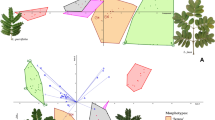Abstract
Field studies in Amazonian Peru show that thePassiflora vitifolia complex, a microcosm of many larger taxa, is concentrated in Amazonia with 4 ecologically separated species. One species is restricted to seasonally inundated forests, a second to non-inundated white sand soils, a third to non-inundated lateritic soils, and the fourth mostly to non-inundated alluvial soils. A new combination is formally proposed to recognize the white sand taxon, previously regarded as a variety, as a distinct species:P. involucrata. The importance of β-diversity in maintaining high Amazonian species diversity is emphasized.
Similar content being viewed by others
References
Baker, H. G., 1970: Evolution in the tropics. — Biotropica2, 101–111.
Benson, W. W., 1978: Resource partitioning in passionvine butterflies. — Evolution32, 493–518.
Fischer, A. G., 1960: Latitudinal variations in organic diversity. — Evolution14, 64–81.
Gentry, A. H., 1974a: Flowering phenology and diversity in tropicalBignoniaceae. — Biotropica6, 64–68.
—, 1974b: Coevolutionary patterns in Central AmericanBignoniaceae. — Ann. Missouri Bot. Gard.61, 728–759.
—, 1976:Bignoniaceae of southern Central America: Distribution and ecological specificity. — Biotropica8, 117–131.
—, 1978: Diversidade e regeneração da capoeira do INPA, com referencia especial asBignoniaceae. — Acta Amazonica8, 67–70.
Gentry, A. H., 1979a: Extinction and conservation of plant species in Tropical America: a phytogeographical perspective. — InHedberg, I., (Ed.): Systematic Botany, Plant Utilization and Biosphere Conservation, 110–126. — Stockholm: Almquist & Wiksell.
—, 1979b: Distribution patterns of neotropicalBignoniaceae: some phytogeographic implications. — InLarsen, K. &Holm-Nielsen, L., (Ed.): Tropical Botany, 339–354. — London: Academic Press.
—, 1980: Phytogeographic patterns in northwest South America and southern Central America as evidence for a Chocó refugium. InPrance, G., (Ed.): The Biological Model of Diversification in the Tropics. — New York: Columbia University Press (in press).
Gilbert, L., 1975: Ecological consequences of a coevolved mutualism between butterflies and plants. — InGilbert, L., Raven, P., (Eds.): Coevolution of Animals and Plants, 210–240. — Austin: Univ. of Texas Press.
- 1979: Coevolved food webs, mobile links, keystone mutualists, and the management of neotropical diversity. — InSoule, O., & Wilcox (Eds.): Sinauer Publ. (in press).
Janzen, D. H., 1968: Reproductive behavior in thePassifloraceae and some of its pollinators in Central America. — Behavior32, 33–48.
—, 1970: Herbivores and the number of tree species in tropical forests. — Am. Natural.104, 501–528.
—, et al. 1976: Changes in the arthropod community along an elevational transect in the Venezuelan Andes. — Biotropica8, 193–203.
Harper, J. L., 1969: The role of predation in vegetation diversity. — Brookhaven Symposia in Biology22, 48–62.
Heithaus, E. R., 1974: The role of plant-pollinator interactions in determining community structure. — Ann. Missouri Bot. Gard.61, 675–691.
Hilty, S. L., 1980. Flowering and fruiting periodicity in a premontane wet forest in Pacific Colombia. — Biotropica12 (in press).
Johnson, M., Raven, P., 1970: Natural regulation of plant species diversity. — InDobzhansky, T., & al. (Eds.): Evolutionary Biology4, 127–162.
Killip, E. P., 1938: The American species ofPassifloraceae. — Field Mus. Nat. Hist., Bot. Ser.19, 1–613.
Kinzey, W. G., Gentry, A. H., 1979: Habitat utilization in two species ofCallicebus. — InSussman, R., (Ed.): Primate Ecology: Problem-oriented Field Studies, 89–100.
MacArthur, R. H., 1965: Patterns of species diversity. — Biol. Rev.40, 510–533.
—, 1970: Species packing and competitive equilibrium for many species. — Theor. Popul. Ecol.1, 1–11.
—, 1972: Geographical Ecology. — New York: Harper and Row.
Masters, M. T., 1872:Passifloraceae. — InMartius: Fl. Bras.13(1, 531–627.
Opler, P. A., 1974: Oaks as evolutionary islands for leaf-mining insects. — Am. Scient.62, 67–73.
Pianka, E. R., 1966: Latitudinal gradients in species diversity: a review of concepts. — Am. Natur.100, 33–46.
Prance, G. T., 1973: Phytogeographic support for the theory of Pleistocene forest refuges in the Amazon Basin, based on evidence from distribution patterns in Caryocaraceae, Chrysobalanaceae, Dichapetalaceae and Lecythidaceae. — Acta Amaz.3, 5–28.
—, 1976: Inventario florestal de um hectare de mata de terra firme km. 30 da Estrada Manaus-Itacoatiara. — Acta Amaz.6, 9–35.
Prance, G. T., 1977: The phytogeographic subdivisions of Amazonia and their influence on the selection of biological reserves. — InPrance, G., Elias, T., (Eds.): Extinction is Forever, 195–213. — New York: The New Botanical Garden.
—, 1978: The origin and evolution of the Amazonian flora. — Interciencia3, 207–222.
Roemer, M., 1846: Synopsis monographicaPeponiferarum ⋯Passifloracearum. — Fam. Nat. Syn.2, 125–207.
Scott, N. J., 1976: The abundance and diversity of herpetofaunas of tropical forest litter. — Biotropica8, 41–58.
Snow, D., 1965: A possible selective factor in the evolution of fruiting seasons in tropical forest. — Oikos15, 274–281.
Strong, D. R., 1974: The insects of British trees: community equilibration in ecological time. — Ann. Missouri Bot. Gard.61, 692–701.
Tramer, E. J., 1974: On latitudinal diversity gradients in avian diversity. — Condor76, 123–130.
Vandermeer, J. H., 1970: The community matrix and the number of species in a community. — Am. Nat.104, 73–79.
—, 1975: A graphical model of insect seed predation. — Am. Nat.109, 147–160.
Whittaker, R. H., 1960: Vegetation of the Siskiyou Mountains, Oregon and California. — Ecol. Monogr.30, 279–338.
—, 1969: Evolution of diversity in plant communities. — Brookhaven Symp. Biol.22, 178–196.
—, 1972: Evolution and measurement of species diversity. — Taxon21, 213–251.
Author information
Authors and Affiliations
Rights and permissions
About this article
Cite this article
Gentry, A.H. Distributional patterns and an additional species of thePassiflora vitifolia complex: Amazonian species diversity due to edaphically differentiated communities. Pl Syst Evol 137, 95–105 (1981). https://doi.org/10.1007/BF00983208
Received:
Issue Date:
DOI: https://doi.org/10.1007/BF00983208




